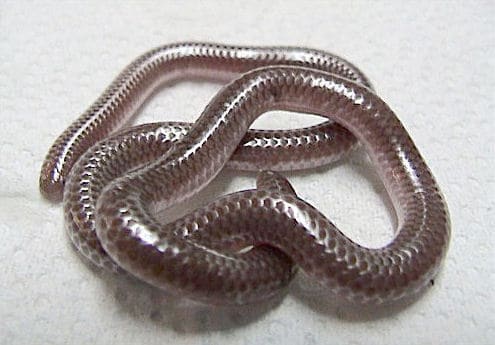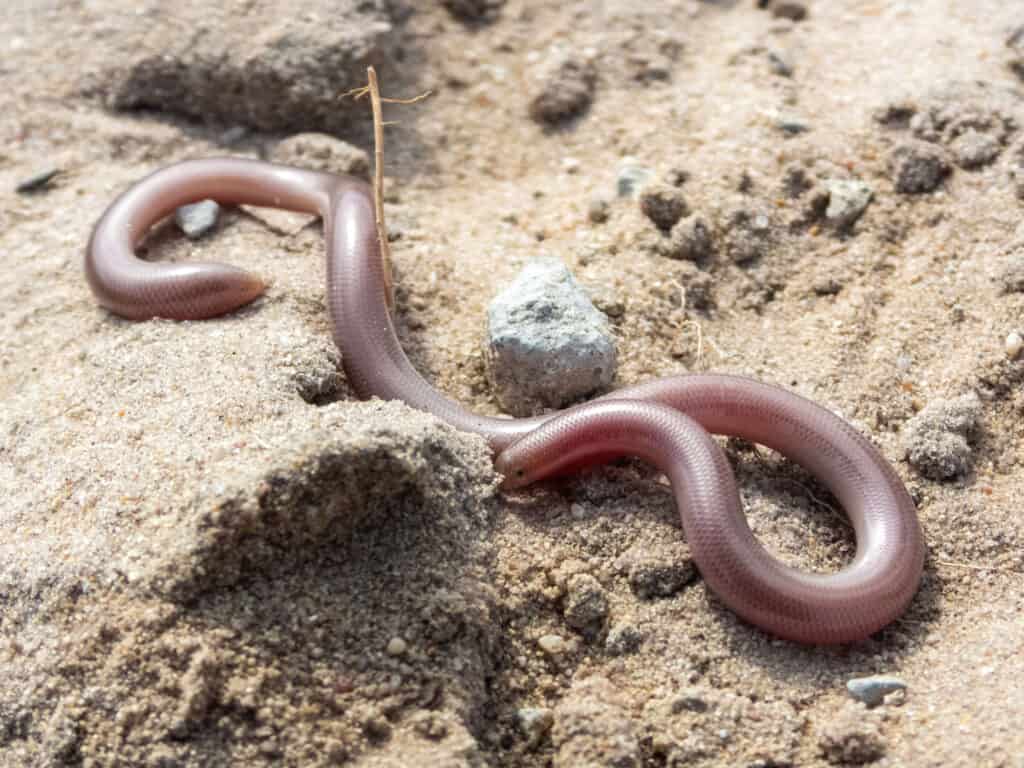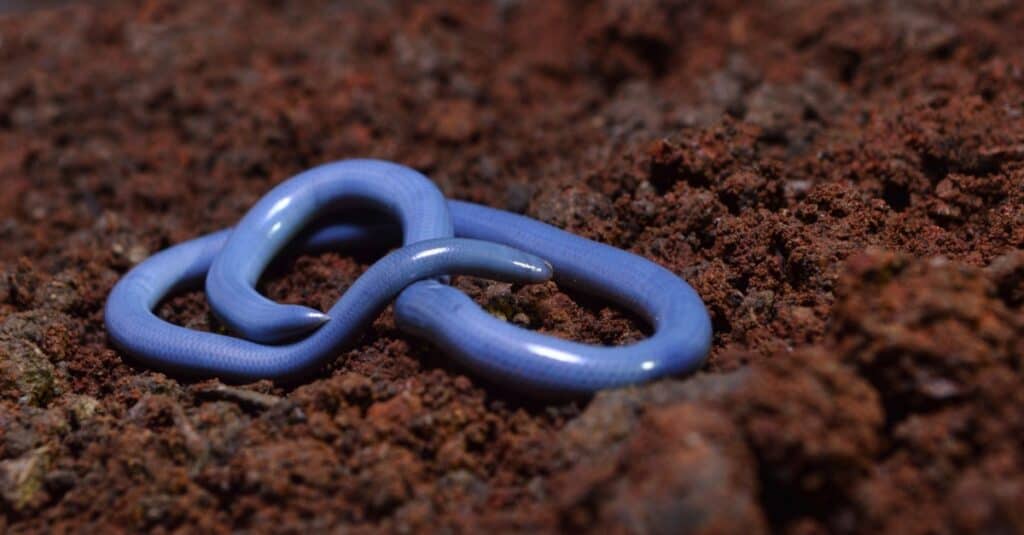The Texas blind snake, also known as the Texas slender blind snake or Texas thread snake, belongs to the Kingdom Animalia and order Squamata.
The snake has a very narrow body, measuring 4-11 inches in length. Due to its feeding habits, the Texas blind snake is considered beneficial. Apart from being docile, the snake is not venomous, meaning it can be kept as a pet.
This article will discuss every important aspect of the Texas blind snake ever recorded, including its diet, habitat, behavior, where it can be found, and how it reproduces.
Let’s begin with a description of the creature.
What does the Texas blind snake look like?

The Texas blind snake looks like an
earthworm
at first sight.
©LA Dawson / CC BY-SA 2.5 – License
The Texas blind snake has a unique appearance, making it look different from other snakes. At first sight, it looks like an earthworm.
If you are looking for a Texas blind snake, the first thing you’ll see is a brown or reddish glistening skin with a silver tone to it. After looking closely at a Texas thread snake and an earthworm, you’ll notice that the snake has scales.
Besides, its eyes are too small, appearing as black dots on its head. In fact, its eyes appear as if they are buried under layers of opaque scales. Additionally, the Texas blind snake has a blunt head with a shorter lower jaw than its upper one.
What is the largest Texas blind snake ever recorded?
The largest ever recorded Texas blind snake was 10.75 inches long. However, Texas blind snakes are anticipated to grow to 11 inches long. They weigh about 0.05 oz and move at a moderate speed. Since they are short in length and can cover a small surface area in a stipulated period, they move at a speed of 1.2- 1.5 mph.
What does the Texas blind snake eat?
Texas blind snakes are mainly carnivorous. However, they do not consume a lot of food. Their diet consists of termites, worms, insect larvae, earthworms, and flatworms. Furthermore, termites are the favorite meal for Texas blind snakes.
In most scenarios, they search for food within their territory. During the search for food, Texas blind snakes can destroy nests of other species that lay eggs in the soil. From a particular perspective, they don’t experience significant challenges in the search for food because they can follow termites and ant trails to where they have formed a nest.
Since the Texas blind snake does not ultimately see what’s around it, it relies on the sense of smell to track down chemical trails left by ants and termites, among other prey.
After finding an insect or insect larvae, the Texas blind snake utilizes its lower jaw to rake the prey into its mouth before swallowing it. Furthermore, its eating method can be compared to a household vacuum cleaner sucking up dirt from a carpet.
Where does the Texas blind snake live?
Texas blind snakes are primarily found in woodland, shrubland, or savanna habitats. Surprisingly, this creature utilizes its blunt snout as a shovel to dig and burrow into the moist soil, thus creating tunnels.
At some point, they can make their way out of their usual habitat into a home setting, searching for areas with numerous insects to consume. In most scenarios, they show up above the ground after heavy storms.
Where is the Texas blind snake found?
Texas blind snakes are popular in North America, more so in the United States. In the US, they are not only found in Texas but also in the western parts of Oklahoma and Arizona. The snake is also found in New Mexico.
The population of the Texas blind snake is projected to exceed 100,000 adults. Even though there is no meaningful information to show whether the population is increasing, stable, or decreasing, the IUCN Red List of threatened species lists it as Least Concern.
What are the Texas blind snake’s predators?
This snake’s North American habitat offers plenty of the worms and insects it loves to eat. But, there are many animals the Texas blind snake must learn to avoid to keep from becoming a meal itself! Birds like greater roadrunners and eastern screech owls are a persistent threat.
The Texas blind snake can also be hunted by mammals, like moles and skunks, and some fellow reptiles, such as the Chihuahuan night snake.
Is the Texas blind snake dangerous?

The Texas blind snake isn’t poisonous.
©iStock.com/Willem Van Zyl
The Texas blind snake isn’t poisonous, meaning that it is not dangerous. In fact, it does not bite due to the lack of teeth. However, the creature has a tiny mouth and head, making its bite painless if it had teeth. Even though the Texas blind snake is not dangerous, homeowners call it a nuisance in certain situations.
After handling the Texas blind snake, people should wash their hands with soap and water even though it doesn’t bite. The main reason is that snakes can carry bacteria on their scales that are invisible to human eyes. Therefore, an individual keeping the Texas blind snake as a pet should practice washing their hands after handling it.
How does the Texas blind snake behave?
For most of its life, the Texas blind snake hides underground and is timid. It’s one of the docile and shy types of snakes. If you are a reptile fan, there is no doubt that the Texas blind snake is a good pet due to its gentle temperament.
Due to its behavior, a professional can remove the creature from the home’s ductwork or any other place they find it. As it hides in the wild, the Texas blind snake is also likely to hide in its enclosure when kept at home as a pet.
Despite being shy, Texas blind snakes communicate with each other. Since they cannot communicate verbally, they make pheromones. Additionally, they use body language to communicate during courtship.
How does the Texas blind snake reproduce?
Through female pheromones, the Texas blind snake males are able to find females. One male can mate with numerous females during the breeding season. During mating, the male wraps himself around the female under a rock.
The mating season for the Texas blind snakes mainly occurs from late March to June, whereby females are responsible for caring for the laid eggs. After laying the eggs, the hatching period commences in August and ends in September.

Thin and tiny, the Brahminy blind snake is sometimes mistaken for a baby snake of another species.
©RealityImages/Shutterstock.com
Is it Normal for Snakes to Be Blind?
Normally, snakes have poor eyesight in general. They can boost their vision if they feel threatened. Snakes have such poor eyesight that snakes have resorted to flickering their forked tongues to get a sense of their surroundings.
Other Record-Breaking Snakes
If you find record-breaking snakes to be a fascinating subject, here’s one that will make your head spin! Just imagine–what snake broke the record as being the largest venomous snake ever found in the United States? Firstly, guess how much it weighed? A whopping 34 pounds! This famous snake was an eastern diamondback rattlesnake, which also measured 94 inches in length (7 ft 9 in)–about the maximum length these venomous creatures typically grow to. However, the average weight for an eastern diamondback rattlesnake usually peaks at 15 pounds or so.
In 1946, an eastern diamondback specimen was shot by a hunter, identified by only the singular name Rutledge in the 1982 Guinness Book of World Records. While there is no record of where this particular snake was found, eastern diamondback rattlesnakes are a venomous species of pit viper found only in the southeastern United States, between the east coast and the Mississippi River and south to the Florida Keys. Read more about this awe-inspiring snake in the article below.
The photo featured at the top of this post is © iStock.com/Willem Van Zyl
Discover the "Monster" Snake 5X Bigger than an Anaconda
Every day A-Z Animals sends out some of the most incredible facts in the world from our free newsletter. Want to discover the 10 most beautiful snakes in the world, a "snake island" where you're never more than 3 feet from danger, or a "monster" snake 5X larger than an anaconda? Then sign up right now and you'll start receiving our daily newsletter absolutely free.
Thank you for reading! Have some feedback for us? Contact the AZ Animals editorial team.






